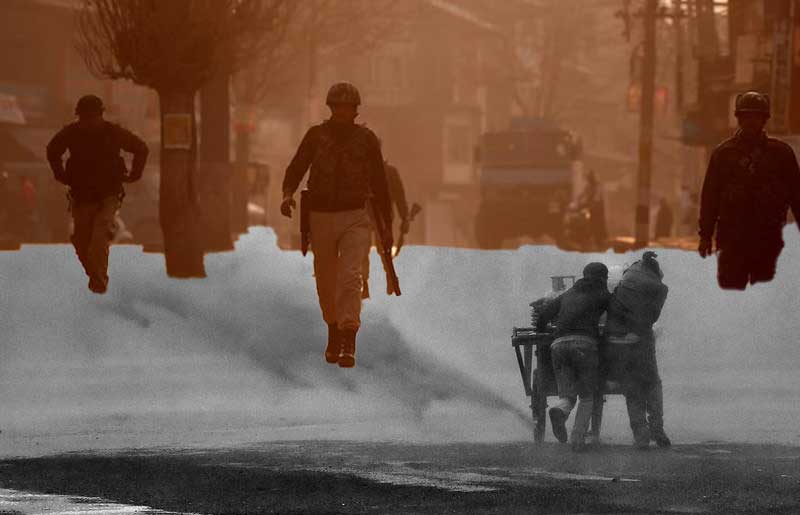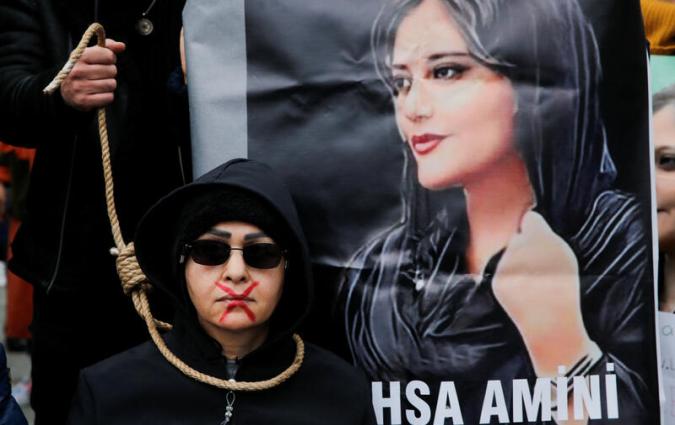In this piece
The 'other' side: How identity shapes local coverage of violent conflict

Composite image shows Indian police officers advancing on Kashmiri demonstrators in 2018 (above), and Kurdish street vendors fleeing the path of a Turkish police water cannon in 2016 (below). (Danish Ismail and Sertac Kayar/Reuters)
In this piece
Identity and source engagement | Self-censorship and protecting sources | The battle over words | Marginalisation within the newsroom and the field | Solidarity across conflict lines | The burden of conflict reporting | ConclusionConflict reporting is fraught with challenges, but these are compounded when journalists share an identity with one of the parties involved in the conflict.
Unlike foreign correspondents who can leave the conflict behind at the end of their assignment, local journalists must continue to live within the same conflict they cover. This proximity to the conflict, both geographically and personally, creates a unique set of pressures and ethical dilemmas.
For many journalists, the task of reporting on “the other side” – those who belong to a different ethnic, religious, or political group – is particularly challenging. How does one approach sources when the reporter's identity might be viewed with suspicion or hostility? What sort of battles do reporters have to fight within their newsrooms to ensure they are able to represent "the other" fairly? And how do they deal with criticism from their own society or the society that they cover due to the work that they do? These are not just hypothetical questions but real challenges faced by journalists working in conflict zones.
As a journalist for Haaretz, covering the Israeli-Palestinian conflict in the West Bank, I have witnessed firsthand how deeply these dynamics can affect the work of a reporter.
To better understand these challenges, I conducted long-form interviews with journalists in Turkey and India who also grapple with the complexities of covering conflicts that intersect with their own identities. Their experiences offer a powerful lens through which to examine the burdens and dilemmas faced by those who must report from within the very societies torn apart by the conflicts they cover.
Identity and source engagement
In conflict zones, where trust is scarce and risks are high, a journalist’s identity can either open doors or shut them firmly. For instance, in Kashmir, a region marred by decades of conflict, journalists face intense scrutiny. Tejas*, a Kashmiri journalist, noted that his identity as a Kashmiri Muslim often influences how non-Kashmiri sources in India perceive him. Even on stories unrelated to the conflict, his ethnicity can change the dynamics of an interview, sometimes leading to suspicion or even hostility.
On the other hand, Preeti*, an Indian journalist covering Kashmir, faces a different set of challenges. She observed that Kashmiris often distrust Indian journalists, viewing them as mouthpieces for the Indian state. This mistrust stems from years of perceived misrepresentation in the national media, where Kashmiris feel their voices are either ignored or distorted to fit a government narrative. As a result, Indian journalists like Preeti must work hard to gain the trust of Kashmiri sources, often relying on local colleagues to bridge the gap.
In Turkey, similar dynamics play out between Turkish and Kurdish journalists. The Kurdish issue, a long-standing conflict within Turkey, presents significant challenges for journalists on both sides. Turkish journalists like Elif*, who report on Kurdish issues, often find that their sources are initially wary of them. Elif sometimes highlights her family’s southeastern origins to build rapport with Kurdish sources, subtly aligning herself with their struggles. Conversely, Kurdish journalists like Irfan Aktan face institutional barriers and personal risks that make accessing official sources nearly impossible.
Turkish journalist and author Ece Temelkuran, has learnt to draw a distinction between what interviewees perceive her as, and the personal. “I didn’t take anything personally. People said horrible things to me, so what? I mean, they’re talking to a Turkish woman, not me,” she said. “I think that in order to tell a story, you have to be nobody anyway. And I like being that nobody. It’s easier for me, because I don’t have to get angry.”
Self-censorship and protecting sources
In both India and Turkey, declining press freedom and increasing state repression have forced journalists to adopt strategies of self-censorship, not only to protect themselves but also their sources. In Kashmir, Preeti described the intense fear that many sources feel when speaking to journalists. To mitigate these risks, she often anonymises her sources and sometimes chooses not to report certain details that could endanger them.
“I’m really scared these days about revealing the identity of sources,” she said, “so I’ve been checking and double checking: ‘Can I quote you; is this OK?’”
The Indian government's crackdown on Kashmiri journalists intensified following the 2019 revocation of Kashmir's autonomous status. Nowadays, Tejas says he is more cautious in his reporting. He said he avoids reporting certain stories, both on Kashmir and in mainland India, fearing the repercussions.
In Turkey, the situation is equally dire. Journalists like Aktan, who work for alternative media, are acutely aware of the dangers their sources face. He recounted how he often revises quotes to remove potentially incriminating language, knowing that a single word could lead to arrest or worse. The Turkish government’s broad anti-terrorism laws are frequently used to silence dissent, making even the most mundane interactions fraught with risk.
The battle over words
Language is a powerful tool in conflict reporting, and the choice of words can have profound implications. Journalists often find themselves at odds with their editors over terminology, particularly when it comes to making decisions over volatile terms such as – militants, separatists, terrorists or freedom fighters. This struggle over language reflects deeper ideological divides and can influence how a story is received by different audiences, as well as have implications on the journalists' ability to work with certain sources or access certain areas.
In Turkey, Elif recalled how the terminology used to describe Kurdish militants shifted depending on the political climate. During peace talks, they were referred to in more neutral terms, but as the peace process collapsed, the language reverted to more inflammatory terms like “terrorists” or “baby killers”.
In India, the terminology used to describe militants in Kashmir is similarly contentious. Tejas recounted how his insistence on using the word “militant” instead of “terrorist” in his reporting led to clashes with his editors. “Several times, particularly while working for national Indian press, they would not agree to change the word ‘terrorist’ to ‘militant’,” he said. “I really felt bad about it and, ultimately, these were the reasons I quit that job. And I remember at times, I would ask them to not write my byline on my story,” he added.
Marginalisation within the newsroom and the field
For many journalists from minority communities, the challenges they face impact their own career trajectories. Within the newsroom, they often encounter discrimination and marginalisation, which can stifle their careers and limit their opportunities. In India, Kashmiri journalists like Tejas and Suhail* have found that their ethnicity often precludes them from covering certain beats or gaining access to high-profile sources. The discrimination is further manifested in general tendency to label Kashmiri journalists as activists and doubt their professionalism within the newsroom
Kurdish journalists in Turkey face significant barriers within the media. Aktan noted that as a Kurdish journalist he is more inclined to be criminalized or harassed by the police when reporting on the ground, which led him to move away from this sort of reporting.
Solidarity across conflict lines
While journalists in both countries suffer persecution by the state, Kashmiri and Kurdish journalists are more frequently targeted and their persecution often involves labelling them and their work as aiding militant separatists. When that happens, journalists said they found little solidarity from their colleagues in the mainstream media.
But there are moments of solidarity between journalists from ostensibly opposed sides of a conflict. In Turkey, a notable example was the “News Watch” initiative in 2016, where journalists from the western part of the country supported their Kurdish colleagues in the southeast. This initiative was a rare instance of cross-conflict solidarity, where journalists from different backgrounds came together to defend press freedom and the public’s right to know.
In India, Kashmiri journalists often feel isolated from their Indian counterparts in the mainstream media, who they said are generally aligned with the government’s stance on Kashmir. While some independent and left-wing outlets and press organisations in India do support Kashmiri journalists, this support is often limited and does little to change the broader dynamics of exclusion and marginalisation.
“If something happens, they come up with statements but that voice is not as solid or influential as it used to be,” said Suhail. “That is partly the fault of the media, because they have become so servile. Nobody bothers with what they are saying. The only time [the authorities] kind of take notice is if the international media covers it.”
The burden of conflict reporting
The toll of reporting on conflict is heavy, particularly for those who report critically on both sides of the conflict. Journalists like Temelkuran, who have been critical of the Turkish government’s actions against Kurds, have faced both professional and personal repercussions. She was fired from her job after writing about the Turkish military’s actions against Kurdish civilians, and she now lives in exile.
“When you’re trying to be in the middle telling the story and you feel responsible only to the story? That’s a very lonely place,” said Temelkuran. “Unfortunately, these are the people targeted the most, because they are targeted by both sides.”
In India, Tejas has been subjected to travel bans and smear campaigns, with one local newspaper publishing a column signed with a pseudonym accusing him of supporting terrorism. Such attacks are not just aimed at silencing journalists; they also serve to isolate them from their communities and families, creating a deep sense of loneliness and alienation.
Conclusion
The experiences of these journalists highlight the profound impact that identity can have on conflict reporting. Whether in Turkey, India, or elsewhere, journalists who cover conflicts from within must navigate a complex landscape of personal risk, professional challenges, and ethical dilemmas.
Their stories reveal the importance of solidarity among journalists, and the challenges in building such networks within the context of declining democracy and a conflict. The ability to amplify the voices and stories of victimised groups is further restricted by the decline in press freedom, forcing even the most dedicated and critical journalists to resort to self-censorship in the face of concrete danger.
The dilemmas and hardships that journalists in those positions face call for a more honest and collaborative discussion among journalists – one that is rarely possible in the heated debates that surround conflicts. The insights shared here may offer a starting point for conversations of this kind.
*Names changed to protect the identity of journalists.
For a more in-depth read, download Hagar’s full project in PDF form below.
In every email we send you'll find original reporting, evidence-based insights, online seminars and readings curated from 100s of sources - all in 5 minutes.
- Twice a week
- More than 20,000 people receive it
- Unsubscribe any time



